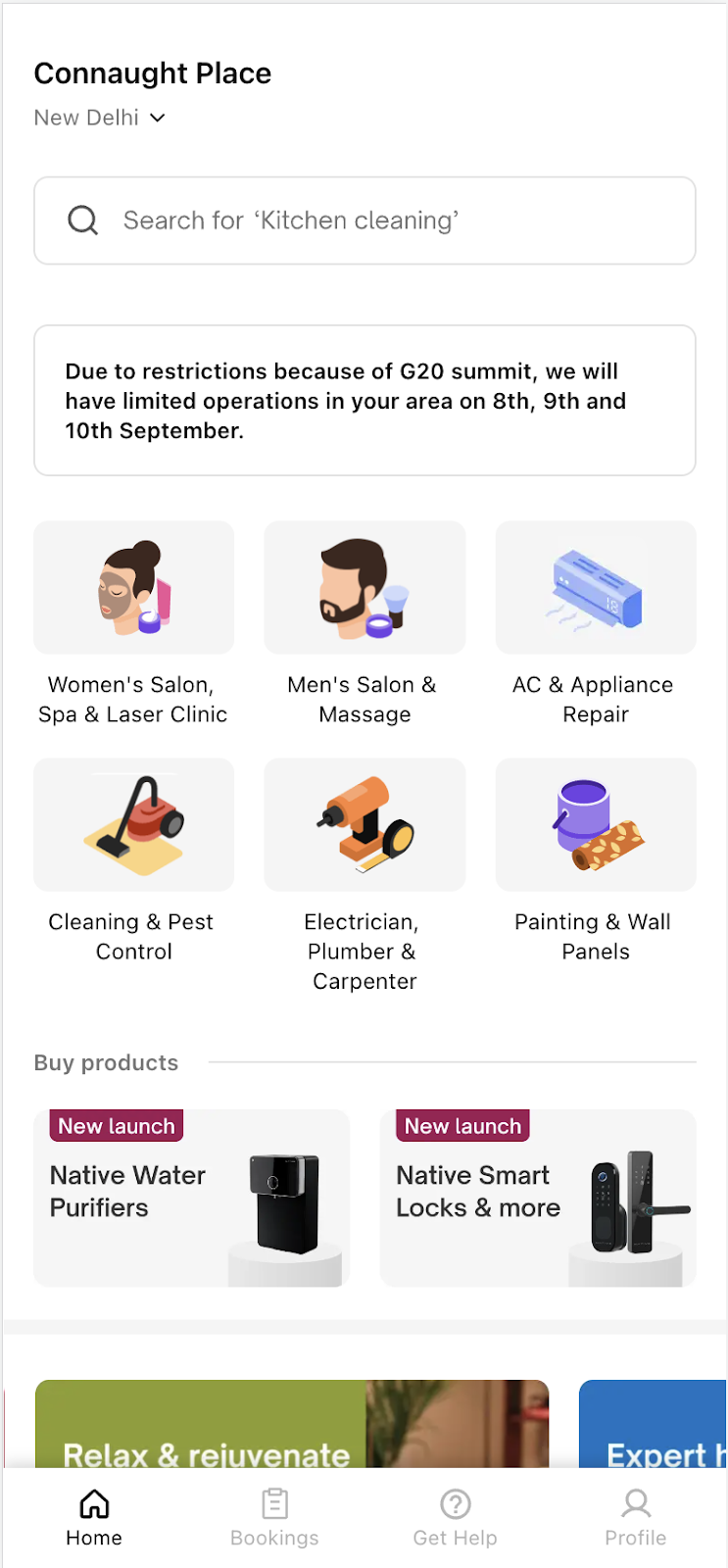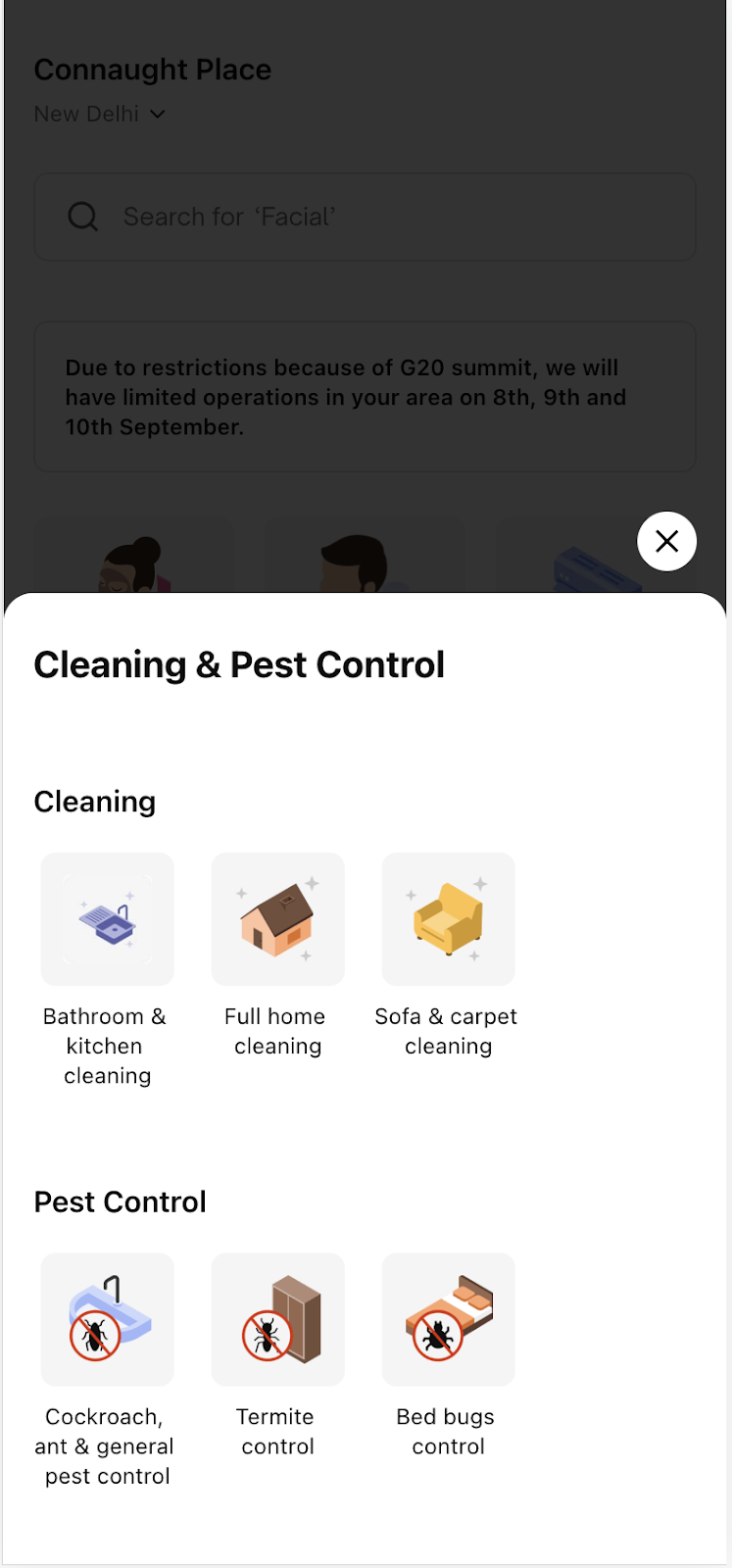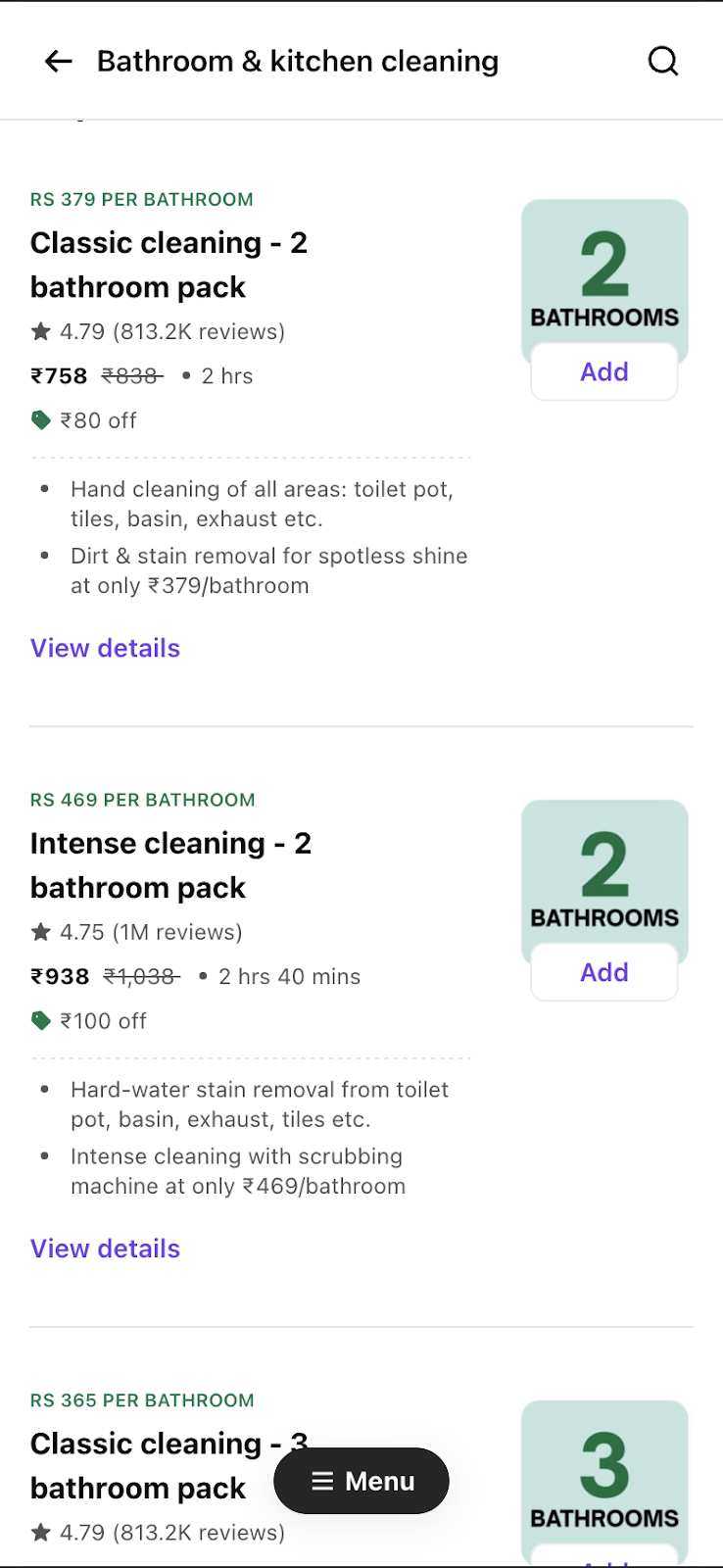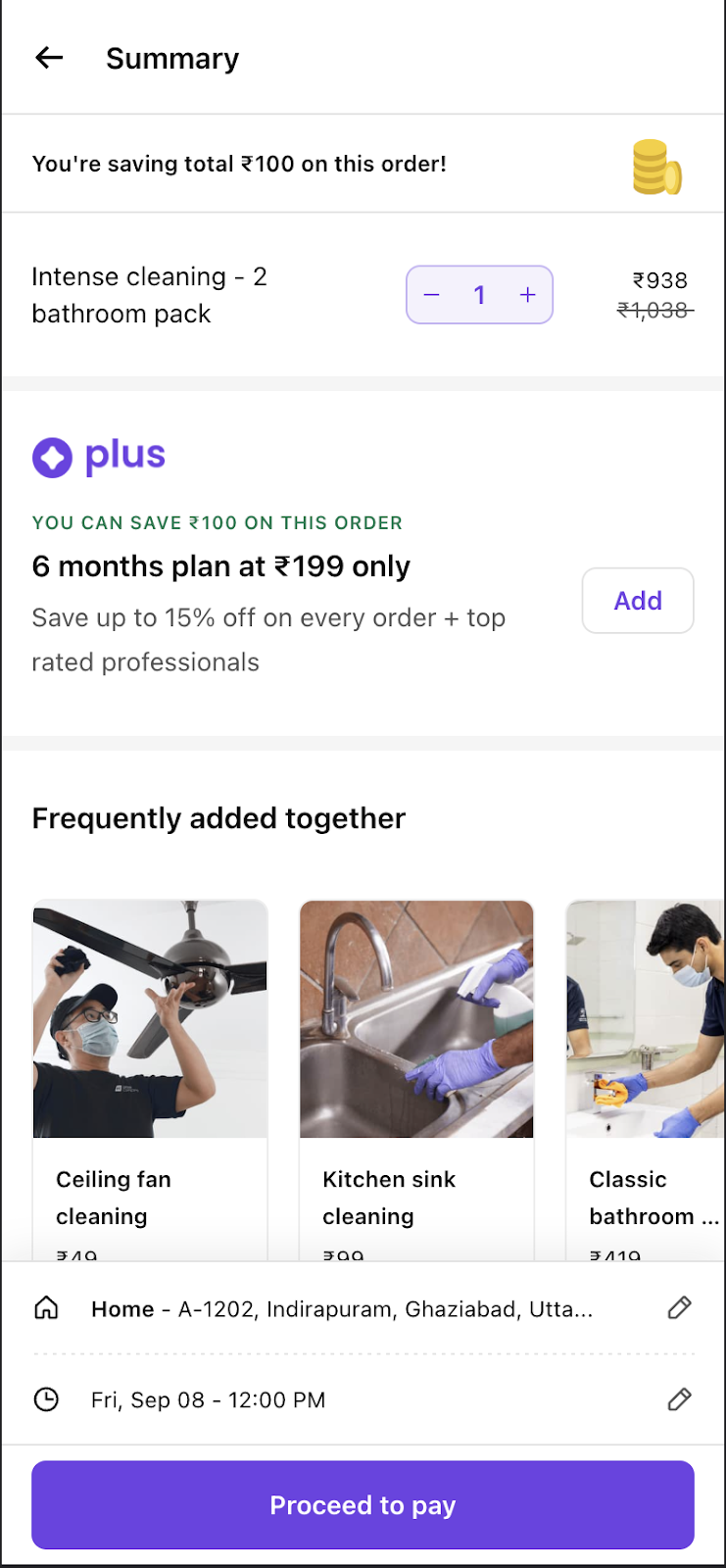Improve Urban Company UX
Problem Statement
You are a PM at Urban Company. You have been asked to improve the user experience on the platform. Please pick one persona and talk about how you would improve their experience via a new feature or by improving an existing feature.
1. What persona did you pick & why?
2. What would you choose to build for this persona? How would this improve their user experience?
3. What would be the MVP that you would want to launch? What would you add as the next version of improvements?
4. How would you measure success of this feature? 5. What are potential risks if any of launching this feature, how would you mitigate them?
About Company
Urban Company is a leading online platform that connects users with a wide range of home services. Operating in various cities, it offers services such as home cleaning, plumbing, electrical repairs, beauty treatments, and more. Users can easily book skilled and vetted professionals through their website or mobile app. Urban Company's commitment to quality, convenience, and reliability has made it a trusted choice for individuals seeking efficient solutions for their home and personal care needs. With a focus on user satisfaction and a vast network of service providers, Urban Company has become a go-to platform for modern urban living.
User Segment
Urban Company primarily targets urban and semi-urban residents, focusing on a diverse user segment that includes:
- Working Professionals: Individuals with busy schedules who require convenient home services such as cleaning, repairs, and beauty treatments to save time.
- Families: Families seeking reliable and efficient services to manage their household chores, maintenance, and occasional pampering.
- Young Adults: Millennials and Gen Z individuals looking for on-demand services to maintain their homes and enhance their personal grooming
- Homeowners: Property owners in need of regular maintenance and repairs for their homes.
- Businesses: Small businesses and startups seeking office cleaning, maintenance, and other commercial services.
- Event Planners: Event organizers looking for event-specific services like catering, photography, and decoration.
- Senior Citizens: Elderly individuals who require assistance with home-related tasks and healthcare services.
Urban Company's wide range of services caters to the diverse needs of these user segments in urban and semi-urban areas, providing convenience and reliability for their daily lives.
User Persona
Basic Information
- Name: Rajesh
- Age: 29 years
- Location: Delhi NCR
- Monthly Salary: ₹1.3 Lakhs
Background:
Rajesh is a 29-year-old IT professional residing in Delhi NCR. He lives in a 3BHK house within a society. Due to his demanding job, he spends most of his time in the office and has minimal interaction with local people. Although he has hired a maid to clean the house, the maid only focuses on cleaning the floors. Rajesh finds it challenging to maintain his entire house, including cleaning and repairs.
Goals and Needs
- Rajesh needs his house's bathroom to be cleaned on a monthly or bi-monthly basis.
- He often requires different experts for various household tasks, which change from month to month.
- Quality is a top priority for Rajesh, and he expects high-quality products and services.
Challenges
- Rajesh struggles to find reliable professionals for cleaning and repairs every month due to his busy schedule.
- He has had unsatisfactory experiences with local vendors whose work quality did not meet his standards.
- The rates charged by local vendors are inconsistent and not fixed.
Behaviour
- Rajesh is tech-savvy and uses multiple devices for his daily tasks.
- He prefers to make online payments for convenience and security.
- Quality service and a guarantee are essential factors for Rajesh when choosing service providers.
User Journey
In this user journey, we will follow Rajesh, an Urban Company user who has been using the app for the past two months. Rajesh already has the Urban Company app installed on his mobile device, and he is now looking to book services: bathroom cleaning, Refrigerator cleaning and Some other mini-cleaning. As we accompany Rajesh on his journey, we will explore his experiences, needs, and pain points to enhance his overall satisfaction with the platform.
1. Dashboard
| Scenario: When a user opens the Urban Company app, they are directed to the Dashboard. |
|---|
| User's Need: The user is looking for listings of services in the Bathroom Cleaning and Refrigerator Cleaning categories. |
| User's Thoughts: The user realizes that they often need the same type of services repeatedly and currently must navigate through multiple categories to find them. This repetitive process can be cumbersome and time-consuming. In this instance, the user decides to explore the Cleaning category. |
| Pain Point: Despite frequently using similar services, the user faces the inconvenience of navigating through various categories each time they need assistance, which can be frustrating and inefficient. |

2. Cleaning & Pest Control
| Scenario: After entering the Cleaning section from the Dashboard, the user seeks to discover various cleaning services. |
|---|
| User's Need: The user is looking for specific services, such as microwave cleaning and Refrigerator cleaning, within the Cleaning category. |
| User's Thoughts: Upon entering the Cleaning page, the user is uncertain about how to locate specialized cleaning services like microwave and Refrigerator cleaning. The category labels, such as Kitchen, Bathroom, and House, do not clearly indicate where these services can be found. Feeling a bit lost, the user decides to explore the Kitchen section for now. |
| Pain Point: The user faces confusion and frustration in their search for specific cleaning services like Refrigerator and microwave cleaning because the category labels do not adequately define and organize these smaller, specialized services |

2. Bathroom & Kitchen
| Scenario: The user proceeds from the categories to the service menu section. |
|---|
| User's Need: The user aims to select specific services for their house. |
| User's Thoughts: As the user enters the Bathroom menu, they are perplexed by the numerous similar options. They wonder about the distinctions between services labelled as Classic and Intense. Additionally, the presence of two bathroom packages confuses them; they contemplate if it's possible to customize based on their requirements. Despite the confusion, the user decides to proceed with booking one bathroom cleaning for the moment. |
| Pain Point: The service menu presents challenges due to redundant listings of similar cleaning services. The user finds it difficult to discern the differences between options like Classic and Intense. Furthermore, the presence of multiple bathroom packages without clear differentiators adds to the confusion. The need to scroll through a lengthy list compounds the issue, making it hard for the user to make a confident comparison between services. |

2. Summary
| Scenario: After selecting services, the user navigates to the Summary Page. |
|---|
| User's Need: The user wants to ensure that all selected services are accurately listed and to review the total cost along with any additional details. |
| User's Thoughts: Upon arriving at the Summary Page, the user checks to confirm that all chosen services are correctly displayed. They notice that the prices align with what was seen in the menus. However, they momentarily struggle to locate the total amount. After a quick scroll, they find it and proceed to pay and checkout. |
| Pain Point: The user faces a slight inconvenience in locating the total amount due, as it is not immediately visible. They are relieved to find it after a brief search. Additionally, the user returns to this page after slot selection, which could potentially cause some redundancy or confusion in their journey. |

Constraints of the System
The current challenge lies in the complexity of selecting services on the platform, resulting in a cumbersome and time-consuming process for users. The issue mainly revolves around service menu navigation, with no immediate focus on payment or summary-related difficulties.
This problem directly contributes to user frustration as they struggle to find the precise service they require, ultimately leading to an increase in the Churn Rate. Even when users have a clear idea of the desired service, the convoluted menu structure hinders their ability to navigate effectively.
By addressing this problem, we anticipate several positive outcomes:
- Increased Booking Rates: Simplifying the service selection process will likely lead to a higher number of bookings.
- Enhanced Booking Per Service: Improved menu clarity may encourage users to explore and book a broader range of services.
- Elevated Net Promoter Score (NPS): A more user-friendly platform should boost user satisfaction and overall NPS.
- Reduced Churn Rate: Streamlining service selection should mitigate user frustration and reduce the likelihood of users leaving the platform.
Focusing on making service selection more user-friendly represents a significant step toward improving the overall user experience and achieving key business objectives.
Solution
Personalized Service Recommendations
To streamline the service selection process, we propose the implementation of a recommendation system tailored to each user's preferences and past activity. This system will ensure that when a user opens the app, they are presented with a curated list of services aligned with their interests.
The recommendation system will draw from the following sources:
1. Recent Viewed Services: Services the user has recently browsed will be considered for recommendation.
2. Recent Purchases: Previous purchases will inform the system about the user's preferences.
3. Related Mini-Services: Additional services frequently selected in conjunction with main services by other users.
4. User's Interests from External Platforms: Incorporate data on topics or services the user has shown interest in on external platforms like Google.
5. Location-Based Recommendations: Leverage the user's current location, specifically within their society, to provide services that are popular in that area. This includes highlighting any new offerings available in their vicinity.
Through this personalized recommendation system, users will be presented with a list of four highly relevant services that they can directly add to their cart for a seamless checkout experience. This solution aims to significantly enhance the user's ability to quickly find and select the services they need.
Streamlining the Menu Section
The objective is to streamline the menu section, addressing three key challenges. Firstly, through Smart Categorization, we'll divide services by specific areas where they are performed. For instance, under Cleaning, we'll categorize services into Kitchen, Bathroom, Living Room, and Whole House. Similarly, under Salon, services will be categorized into Hair Cut, Pedicure, Manicure, etc.
Secondly, we'll facilitate easy comparison of similar services within categories. For example, in the Cleaning section, when a user selects Kitchen Cleaning, they'll have the option to compare variations like Intense, Move-In, and Regular cleaning. This will empower users to make informed choices with clarity.
Lastly, we aim to eliminate redundancy in the menus. By implementing Smart Categorization and enabling effective comparisons, we'll reduce the need for duplicate or overlapping menu items, creating a more intuitive and user-friendly experience within the Urban Company app. This solution is designed to enhance user efficiency and satisfaction when selecting services.
Phases Of Release
Phase 1
In this initial phase, we will focus on displaying the most recent service that users have ordered. We will also optimize the category layout for better user navigation and clarity.
Phase 2
In the second phase, we will introduce recommendations based on easily accessible data sources such as recent searches, past purchases, and popular mini services. Additionally, we will streamline the menu by removing redundant items and further simplifying the user experience.
Phase 3
The final phase will mark the full-scale release of the updated features. This comprehensive update will completely transform the menu structure and incorporate a wide range of personalized recommendations based on various user behaviors and preferences. This phase represents a significant enhancement of the user experience and menu functionality.
Metrics
North Star Metric
- Number of Services Added to Cart
Level 1 Metrics:
1. Total Recommendations Viewed by Users
2. Total Number of Visits to the Menu Page
3. Total Time Spent on the Menu Page
4. Frequency of Menu Page Visits per User
By analyzing these metrics, we can gauge the success of the desired product. The North Star Metric, indicating the number of services added to the cart, serves as a primary indicator of user engagement and conversion. Additionally, Level 1 Metrics such as the total recommendations viewed, visits to the menu page, time spent on the menu page, and the frequency of menu page visits per user provide further insights into user interaction and satisfaction with the menu section. These metrics collectively offer a comprehensive view of the product's performance and its impact on user behavior and experience.
Risks Mitigatetion Plan
1. Technical Challenges
Risk: Potential technical difficulties in implementing the recommendation system and menu restructuring.
Mitigation Conduct thorough testing, including beta testing with a small user group, to identify and address any technical issues before full-scale deployment.
2. User Adoption
Risk Users may initially resist or find it challenging to adapt to the new menu structure and recommendation system.
Mitigation Provide in-app tutorials and guides to familiarize users with the updated features. Collect and respond to user feedback promptly to address any concerns or confusion.
3. Data Privacy and Security
Risk Concerns about user data security and privacy, particularly with the implementation of recommendation algorithms.
Mitigation Ensure robust data encryption measures are in place. Clearly communicate the platform's commitment to data protection and privacy through privacy policies and terms of use.
4. User Experience Degradation
Risk Changes to the menu and recommendation system may inadvertently lead to a less intuitive or user-friendly experience.
Mitigation Conduct extensive user testing and usability studies to validate the changes. Continuously monitor user feedback and metrics to identify and address any UX issues.
5. Overwhelming Recommendations
Risk Users may feel inundated with recommendations, potentially leading to decision paralysis.
Mitigation Implement user preferences settings to allow individuals to customize the level of recommendations they receive. Provide options for users to opt-out of certain types of recommendations.
6. Inaccurate Recommendations
Risk The recommendation system may occasionally provide suggestions that do not align with the user's preferences or needs.
Mitigation Continuously refine and improve the recommendation algorithm through machine learning and feedback loops. Provide users with the ability to provide feedback on recommendations.
7. Loss of Menu Diversity:
Risk Overemphasis on recommendations may lead to certain services being overlooked or underutilized.
Mitigation Ensure that users still have easy access to the full range of services through clear navigation and search options. Monitor service usage to identify any significant disparities.
8. Resistance from Service Providers:
Risk Service providers may face challenges in adapting to the new system or may be concerned about changes in user behavior.
Mitigation Provide training and resources to service providers to help them understand and adapt to the updated platform. Communicate the benefits of the changes in terms of increased user engagement and bookings.
By proactively identifying and addressing these potential risks, we can implement effective strategies to mitigate any challenges that may arise during the implementation of the recommendation system and menu restructuring.